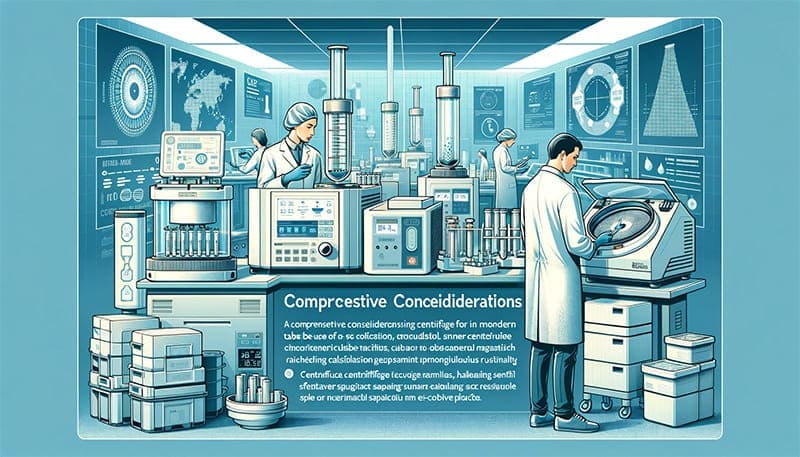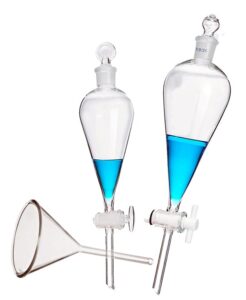Have you ever wondered how scientists separate complex mixtures in a lab? Or maybe you’re starting a career in science and feel overwhelmed by the laboratory equipment? One of the essential tools in a lab is the centrifuge tube, but how do you use it effectively?
Centrifuge tubes are vital in laboratories for separating and preparing biological samples. Their use ranges from basic academic experiments to advanced research. Understanding how to use them correctly is crucial for anyone in the scientific field.
Keeping you engaged and informed is our goal, as we delve into the world of centrifuge tubes.

What is a Centrifuge Tube?
A centrifuge tube is a specialized container designed for use in a laboratory centrifuge, a device that rotates samples at high speeds. The primary function of this tube is to hold samples during the centrifugation process. Here’s a more detailed explanation:
- Material: Centrifuge tubes are typically made from durable materials like polypropylene (PP), polyethylene (PE), or polycarbonate (PC). These materials are chosen for their strength and resistance to chemicals, as well as their ability to withstand the high-speed rotation and varying temperatures often encountered during centrifugation.
- Compatibility with Equipment: These tubes are specifically designed to fit securely in the rotor of a centrifuge. The rotors are the rotating parts of the centrifuge that hold the tubes. Their design ensures that the tubes remain stable and secure during the intense spinning process, which is crucial for the safety and effectiveness of the separation.
- Purpose: The main purpose of a centrifuge tube is to facilitate the separation of different components of a liquid mixture based on their densities. When placed in a centrifuge and spun at high speeds, the contents of the tube experience centrifugal force. This force causes denser particles to move outward towards the bottom of the tube, while less dense components remain closer to the top. This process is widely used in scientific research and clinical laboratories for tasks such as separating blood components, purifying DNA, isolating different cellular components, and much more.
A centrifuge tube is an essential laboratory tool made from robust, chemical-resistant materials, designed for use in centrifuges, and utilized for separating mixtures based on the density of their components.

Guidelines for Using Centrifuge Tubes in Laboratory Experiments
Centrifuge tubes are pivotal in laboratory experiments for precise sample separation and preparation. This article, titled ‘Guidelines for Using Centrifuge Tubes in Laboratory Experiments,’ offers a concise overview of selecting and utilizing these tubes effectively. Aimed at enhancing laboratory efficiency and sample integrity, these guidelines are essential for both novice and experienced researchers.
Here’s how to use them in experiments and some important considerations:
- Choosing the Right Centrifuge Tube:
- Select the appropriate material for the centrifuge tube based on experimental needs. Common materials include polypropylene (PP), polyethylene (PE), and polycarbonate (PC).
- Choose the right size and capacity of the centrifuge tube depending on the type and quantity of the sample to be separated.
- For samples requiring high or low-temperature treatment, select centrifuge tubes that can withstand these temperatures.
- Sample Preparation:
- Add the sample to be separated into the centrifuge tube, ensuring not to exceed its maximum capacity.
- Add stabilizers, preservatives, or other additives as needed for the experiment.
- Securely cap the centrifuge tube to prevent spillage during centrifugation.
- Centrifugation Process:
- Place the centrifuge tube in the centrifuge machine and set the speed and duration according to experimental requirements.
- Start the centrifuge to begin separation. Monitor the centrifuge’s operation to ensure the process is running smoothly.
- Pay attention to the placement of the centrifuge tube to ensure it remains stable and does not wobble.
- Sample Processing:
- After centrifugation, remove the supernatant or sediment from the centrifuge tube for further analysis and processing.
- If cleaning of the centrifuge tube is required, use appropriate detergents and rinse with water, then dry with a clean cloth.
- Dispose of used centrifuge tubes according to laboratory waste disposal guidelines to avoid environmental and health hazards.
- Safety and Maintenance:
- Exercise caution to avoid injury from spillage or corrosive samples.
- Wear protective gear and gloves when handling radioactive or toxic samples and follow relevant regulations.
- When using the centrifuge, select appropriate rotor heads and ensure balance to prevent damage to the machine or injury.
- Handle samples gently to avoid spillage or damage to the centrifuge tubes.
- Be careful when cleaning tubes to avoid cuts, and use suitable detergents and water.
- Record experimental processes and results for future reference and analysis.
- Clean the work area promptly after experiments, especially when dealing with hazardous liquid waste.
- For unfamiliar samples or experimental conditions, conduct small-scale trials or seek professional advice.
- Regularly check and maintain the centrifuge to ensure its proper functioning and safety. If any faults or abnormalities are detected, stop the machine and seek professional repair.
- Follow laboratory protocols and procedures when using centrifuge tubes and machines to enhance experimental efficiency and quality. Maintain personal and laboratory hygiene to prevent cross-contamination and bacterial growth.
These guidelines provide a fundamental framework for effectively using centrifuge tubes in lab settings. By carefully selecting, handling, and processing these tubes, researchers ensure the accuracy and safety of their experiments. Embracing these practices is key to maintaining the high standards necessary for successful laboratory research.

Enhancing Laboratory Practices: Effective Use of Centrifuge Tubes
Centrifuge tubes are indispensable tools in the realm of scientific research, offering precision and efficiency in sample separation. In this guide, we delve into the nuances of selecting and utilizing centrifuge tubes in laboratory experiments, ensuring both safety and accuracy. Our aim is to provide a thorough understanding for both beginners and seasoned researchers, enhancing laboratory efficiency and ensuring the integrity of experimental samples.
- Understanding Centrifuge Compatibility: Emphasize the importance of ensuring that the centrifuge tubes are compatible with the centrifuge rotor being used. Different rotors can accommodate different sizes and types of tubes, and mismatched tubes and rotors can lead to accidents or sample loss.
- Balancing Techniques: More detail on balancing centrifuge tubes in the rotor could be beneficial. This includes using tubes of equal weight across from each other and the importance of balancing tubes even when not all positions are filled.
- Sample Volume and Centrifugal Force: Clarify the relationship between the volume of the sample, the size of the tube, and the applied centrifugal force. Different sample volumes may require different centrifugation speeds and times for effective separation.
- Handling of Sensitive or Hazardous Samples: Provide more detailed instructions on handling sensitive or hazardous materials, including biological hazards or chemicals that require special handling procedures.
- Data Recording and Labeling: Stress the importance of proper labeling and data recording for each tube, especially in experiments with multiple samples. This ensures traceability and accuracy in experimental results.
- Emergency Procedures: Include guidelines on what to do in case of an emergency, such as a tube breakage inside the centrifuge, which could be a safety hazard.
- Environmental Considerations: Mention environmentally-friendly practices, such as using recyclable or biodegradable centrifuge tubes where possible, and proper disposal methods for different types of tubes.
- Quality Control: Suggest regular quality control checks for centrifuge tubes, especially in high-precision experiments. This could include checking for defects like cracks or deformities.
- Centrifuge Tube Storage: Provide recommendations for proper storage of centrifuge tubes to prevent contamination and damage. This is especially important for labs with limited space or large inventories of tubes.
- Calibration and Verification: Emphasize the need for regular calibration and verification of the centrifuge, especially for experiments requiring high precision. This ensures the accuracy and reliability of the centrifugation process.
These comprehensive guidelines serve as a valuable resource for anyone involved in laboratory work. By adhering to these practices, researchers can ensure not only the accuracy and safety of their experiments but also contribute to sustainable and responsible laboratory practices. Embracing these guidelines is key to maintaining the high standards necessary for successful and ethical scientific research.

Tips for Beginners
For beginners who are just starting to use centrifuge tubes, here are some detailed tips and essential knowledge that can help you use them effectively and safely:
- Understand the Basics: Before using a centrifuge tube, familiarize yourself with its basic components, materials, and capacities. Knowing the difference between types of tubes (like conical, round-bottomed, or microcentrifuge tubes) and their specific uses is crucial.
- Select the Right Tube for Your Experiment: Choose a centrifuge tube that matches your experiment’s requirements. Consider factors like the tube’s material, size, and maximum speed rating. For instance, some tubes are better for high-speed operations, while others are suited for storage or low-speed centrifugation.
- Proper Sample Preparation: Ensure that your sample is prepared correctly for centrifugation. This includes mixing it thoroughly, avoiding air bubbles, and not exceeding the tube’s maximum fill volume. Overfilling can lead to spillage or tube breakage during centrifugation.
- Balance the Centrifuge: Always balance the tubes in the centrifuge. Tubes should be placed opposite each other to maintain balance. If you have an odd number of tubes, use a balance tube filled with water or a solution of similar density to your sample.
- Use Personal Protective Equipment (PPE): Always wear appropriate PPE, such as lab coats, gloves, and safety glasses, to protect yourself from spills or broken glass in case a tube shatters.
- Set Correct Centrifuge Parameters: Understand and set the correct centrifuge parameters, including speed (RPM) and duration. Different samples require different centrifugation settings. Refer to your experiment protocol for guidance.
- Handle with Care: Centrifuge tubes, especially when filled, can be fragile. Handle them gently to avoid breakage or spills. Always ensure that the lids are securely fastened before centrifugation.
- Regular Maintenance and Inspection: Check and maintain your centrifuge regularly. This includes cleaning the rotor and buckets, checking for signs of wear or damage, and ensuring the machine is calibrated correctly.
- Dispose of Tubes Properly: After use, dispose of the tubes according to your laboratory’s safety and waste disposal guidelines. This is especially important for tubes that have contained hazardous materials.
- Learn from Mistakes: Mistakes are inevitable when you’re learning. If something goes wrong, try to understand what happened and how you can prevent it in the future.
- Seek Guidance: Don’t hesitate to ask for help or advice from more experienced colleagues. They can provide valuable insights and practical tips from their own experiences.
- Stay Informed: Keep yourself updated with the latest practices and safety standards in centrifugation. Reading scientific literature, attending workshops, or joining professional groups can be beneficial.
Remember, practice and patience are key. With time and experience, you’ll become more comfortable and proficient in using centrifuge tubes.

For the Experts
For expert-level laboratory personnel who are well-versed in using centrifuge tubes, continual learning and adaptation are essential for maintaining and enhancing proficiency. Here are some additional reminders and suggestions to keep in mind:
- Explore Advanced Techniques: Stay abreast of and experiment with advanced centrifugation techniques. This includes ultracentrifugation, density gradient centrifugation, and differential centrifugation, which can offer more refined results in complex experiments.
- Innovate and Customize: Don’t hesitate to innovate or customize centrifugation protocols to suit specific research needs. Tailoring methods can lead to more efficient separations and novel discoveries.
- Investigate New Materials and Designs: Keep an eye on the latest developments in centrifuge tube materials and design. Newly engineered materials or tube structures might offer benefits such as improved chemical resistance, enhanced clarity, or better sample recovery.
- Prioritize Safety: Regularly review and update safety protocols, especially when dealing with hazardous materials. Always conduct risk assessments for new procedures and ensure that all safety measures are in place and followed.
- Mentor and Train: Share your knowledge and experience with less experienced colleagues. Mentoring and training new staff not only enhances the overall skill level of your team but also reinforces your own understanding and expertise.
- Collaborate Across Disciplines: Engage in interdisciplinary collaborations. Applying centrifugation techniques in different scientific fields can lead to innovative uses and methodological improvements.
- Regular Equipment Upgrades and Maintenance: Ensure that the centrifugation equipment is regularly upgraded and well-maintained. This includes calibrating the centrifuge, inspecting rotors for wear and tear, and keeping up with software updates for automated systems.
- Participate in Professional Development: Engage in continuous professional development. Attend conferences, workshops, and seminars to stay informed about the latest trends and research in your field.
- Publish and Share Findings: Consider publishing your findings, especially if you develop new techniques or make significant discoveries using centrifugation. Sharing your knowledge contributes to the scientific community and can lead to further advancements.
- Embrace Technology: Utilize software and technology for data analysis and management. Advanced software can provide more accurate interpretations of centrifugation results and streamline the research process.
- Sustainability Practices: Implement and advocate for sustainable practices in the lab. This includes proper recycling of materials and reducing waste where possible, aligning with the growing emphasis on environmental responsibility in scientific research.
- Stay Curious and Open-Minded: Maintain a sense of curiosity and openness to new ideas. Science is ever-evolving, and staying adaptable and open to change is key to staying at the forefront of your field.
Remember, expertise is not just about what you already know, but also about your willingness to learn, adapt, and innovate.

The Role of Centrifuge Tubes in Various Fields
Centrifuge tubes play a crucial role in various scientific fields, from molecular biology to environmental science. Their use in DNA extraction, protein purification, and cell culture is fundamental. Understanding the specific requirements of your field is crucial for selecting the appropriate centrifuge tube and centrifugation conditions.
Cleaning and Sterilization
Cleaning and sterilizing centrifuge tubes are vital for preventing contamination. Methods like autoclaving, using detergents, or UV sterilization are commonly employed. Always follow the manufacturer’s guidelines to avoid damaging the tubes.

Navigating Challenges and Common Mistakes in Centrifuge Tube Usage
Mastering the use of centrifuge tubes in a laboratory setting is a skill that evolves over time, often through a process of trial and error. Recognizing and understanding common challenges and mistakes is integral to this learning process. This expanded guide aims to shed light on typical issues faced by laboratory personnel, offering strategies for adjustment, identifying frequent errors, and suggesting remedial actions.
Common Errors and Their Adjustments
- Overfilling Tubes: Exceeding the maximum capacity of a centrifuge tube is a frequent mistake. Overfilled tubes can lead to spillage, imbalances during centrifugation, and potentially breakage. Adjustment: Always check the maximum volume indicated on the tube and ensure that your sample does not exceed this limit.
- Incorrect Speed Settings: Using an inappropriate speed setting for the type and volume of the sample can lead to incomplete separation or, conversely, damage to delicate samples. Adjustment: Refer to the experiment protocol for the recommended speed (RPM) and adjust the centrifuge settings accordingly. If unsure, start with lower speeds and gradually increase as needed.
- Improper Balancing of Tubes: Failing to properly balance the centrifuge can cause vibrations, noise, and even damage to the centrifuge. Adjustment: Balance the tubes across from each other in the rotor, ensuring that each tube is of equal weight and volume.
Addressing Specific Challenges
- Handling Viscous Samples: Viscous samples can be challenging to centrifuge effectively. Solution: Pre-warm the samples if the protocol allows, to decrease viscosity, and consider longer centrifugation times at lower speeds.
- Dealing with Sensitive Samples: Some samples, such as those containing RNA or live cells, are particularly sensitive. Solution: Use low centrifugation speeds and shorter durations to prevent damage to these delicate samples.
- Tube Breakage: Tubes may crack or break, especially when using high speeds or dealing with chemical reactions. Solution: Regularly inspect tubes for cracks or weaknesses and replace them as needed. Consider using thicker-walled tubes for more rigorous applications.
Remedial Actions for Mistakes
- Spillage Cleanup: In case of spillage due to overfilling or breakage, immediate cleanup is essential. Action: Wear appropriate PPE, contain the spill, and clean it up following your laboratory’s safety protocols, especially if dealing with hazardous materials.
- Sample Loss: If a sample is lost due to incorrect centrifugation, it may need to be prepared again. Action: Review the procedure to identify the error and repeat the preparation with adjustments.
- Equipment Damage: Incorrect usage can sometimes lead to equipment damage. Action: Report any damage to the laboratory supervisor, and ensure the equipment is inspected and repaired before further use.
While encountering challenges and making mistakes with centrifuge tubes is a normal part of the learning process in a laboratory, understanding these common issues and knowing how to address them effectively enhances both the skill and knowledge of the laboratory personnel. Regular reflection on these experiences is key to becoming proficient in laboratory practices.

Comprehensive Considerations for Centrifuge Tube Use in Modern Laboratories
The Importance of Calibration
Regular calibration of your centrifuge is crucial for accurate results. An improperly calibrated centrifuge can lead to errors in separation, affecting the quality of your experiments. Ensure routine checks and calibrations as per the manufacturer’s guidelines.
Handling Sensitive Samples
Dealing with sensitive or volatile samples requires extra caution. Specialized centrifuge tubes designed for hazardous materials should be used. Understanding the physical and chemical properties of your samples is key to selecting the right tube and centrifugation conditions.
Best Practices for Long-Term Use
To ensure the longevity of your centrifuge tubes and equipment, adhere to best practices. Proper storage, handling, and regular maintenance go a long way in preserving their functionality and accuracy.
Keeping Up with Technological Advances
The field of centrifugation is continually evolving, with new technologies and methods being developed. Staying informed about these advancements can enhance your experimental techniques and outcomes.
Networking and Professional Development
Building a network with other professionals and continually investing in your professional development is vital. Attending conferences, joining professional associations, and subscribing to scientific journals are excellent ways to stay connected and informed.
Collaborating and Sharing Knowledge
Collaboration and knowledge sharing are key in the scientific community. Engaging with peers, attending workshops, and participating in forums can provide valuable insights into the use of centrifuge tubes and related techniques.
Innovations in Centrifuge Tube Design
Recent innovations in centrifuge tube design are noteworthy. Features like enhanced chemical resistance, improved clarity, and ergonomic caps have made these tubes more user-friendly and efficient. Staying updated with these advancements can significantly benefit your laboratory work.
Future Trends in Centrifugation
Looking ahead, the field of centrifugation is set to witness more technological advancements. Anticipating future trends, like automation in centrifugation processes or eco-friendly tube materials, can prepare you for the next wave of scientific innovation.
Ethical Considerations
When working with biological samples, ethical considerations are paramount. Adhering to guidelines for the ethical treatment of samples, especially those derived from humans or animals, is not just a legal requirement but a moral obligation.

Final Thoughts
In conclusion, mastering the use of centrifuge tubes is a dynamic and ongoing process. It requires a balance of technical knowledge, practical skills, and an understanding of the broader scientific context. Whether you are a beginner or an expert, there is always more to learn and discover in the world of centrifugation. Embrace the journey with curiosity and dedication, and you will continue to grow and succeed in your scientific endeavors.
Conclusion
The mastery of centrifuge tube use is an ever-evolving journey, rich with opportunities for learning and innovation. This guide aims not only to inform but also to inspire scientists at all levels of expertise. Embrace these guidelines as you navigate the intricate world of laboratory research. Continue to explore, innovate, and share your discoveries. Your dedication and curiosity are key to unlocking new realms of scientific understanding and advancement. Join us in this ongoing quest for knowledge and excellence in the laboratory!










